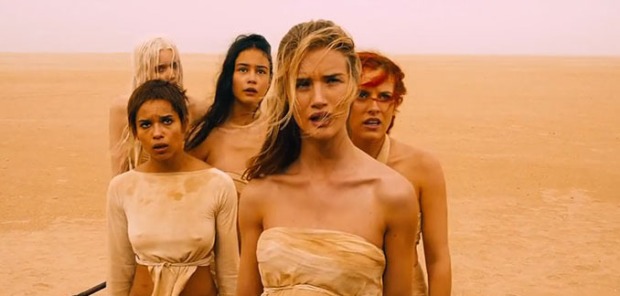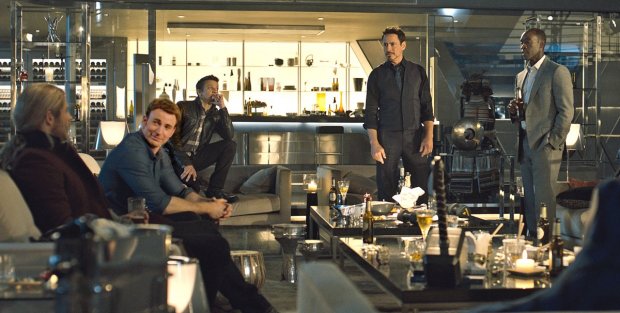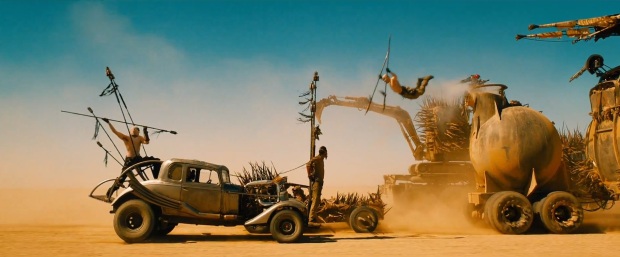Summer blockbuster season begins with two mega-budget colon-sporting action franchise sequels that couldn’t be more different. Mad Max: Fury Road serves as a throwback to the insanity of action movies of the 80’s, while Avengers: Age of Ultron is firmly rooted in contemporary blockbuster filmmaking. While I can recommend both movies, for my money Fury Road is far and away the more interesting of the two. Mad Max succeeds on so many levels, and it really highlights the shortcomings of Avengers, and by extension, many modern action films. Mild [spoilers] for both films from here on.
Visual Storytelling
From the opening scene of Mad Max, it is clear that the movie is not going to be particularly chatty. Situations go largely unexplained, and details about the world are left for the audience to extract for themselves. Probably two-thirds of the story is told during some form of chase sequence. And yet, despite the lack of dialogue, Mad Max is extremely coherent, taking advantage of the inherently visual nature of film. Each frame is capable of conveying plot details and character motivations far more succinctly than words could. Audience members digest this information subconsciously the moment they see the image.
When Max first meets Immortan Joe’s wives, he threatens them at gunpoint. He gestures with the gun, indicating that he wants one specific woman to bring him water and remove the muzzle from his face. As the wife walks towards him, the camera pans upwards from her feet, revealing her belly: she is pregnant. Suddenly the audience understands why this woman was chosen, and the stakes are raised. She gives him the water, while the other wives eye Max, looking for an opportunity to catch him unawares. All of this is conveyed without dialogue. There is no need to explain motivations; the sequence of shots provides all the information needed.
Joss Whedon, on the other hand, is a master of dialogue. Most consider him a writer first and a director second. This is largely what makes him such a perfect fit for the Avengers franchise. By now, the Marvel Cinematic Universe has more story than you can shake a stick at. Avengers: Age of Ultron is building on 10 previous films and laying the piping for at least 4 others. That’s a ton of plot to get through, and really the only answer is a mountain of dialogue and exposition. There’s nothing wrong with this technique, per se, but there are a number of things lost in translation from screenplay to screen.
Take for instance, Ultron’s motivations throughout the movie. In the span of an hour of screentime, Ultron goes from being designed to protect the world, to deciding that protecting the world means killing the Avengers, to later deciding that everyone needs to die in order to protect the world. These major shifts in character motivations take place almost entirely off-screen. Sure, we get some dialogue explaining where the changes of heart might be coming from, but the film has no time to actually show these shifts to us. As a result, the audience is left to fill in the gaps, and Ultron falls completely flat as both a villain and a sympathetic character.
Real Stunts, Real Stakes
If you have seen the trailer for Mad Max: Fury Road, then you know that the movie is completely insane. This is a film in which an irradiated man may kamikaze jump from one vehicle, wielding dual spears and subsequently exploding a second vehicle. Honestly, this example is one of the lesser insane moments the movie holds. What truly adds to the adrenaline rush is that the majority of these moments look real. Oh there is movie magic, of course, and probably some sparse computer-generated imagery, but during filming there was actually a stunt man leaping from vehicle to vehicle. When a car explodes, it actually flips end over end, with actual fire in all directions.

A CGI fight between heroes in ‘Avengers: Age of Ultron’ (Disney)
Stunt work in an action film should be expected and unsurprising; movies in the 80’s and 90’s were built on moments like these. Despite this, I honestly can’t remember the last time I saw a modern movie with so many stunts unaided by CGI. It’s hard to blame filmmakers for this. After all, it is sometimes cheaper and always safer to create some or all of a set-piece within a computer. I don’t at all devalue the incredible work managed by digital effects artists. They work tirelessly to create images out of pure imagination that otherwise simply could not exist.
However, there is real weight to actual stunts that is extremely difficult to convey with computer effects. When a car explodes into flames in front of the heroes, there is a real sense of peril, and real stakes for the characters. When CGI Iron Man fights CGI Hulk through a CGI city, it’s obvious that every detail has been meticulously constructed. The entire scene plays out on rails, much like a roller coaster; there are thrills, sure, but no true sense of danger.
Filmmaking with Purpose
To me, the most striking difference between Mad Max and many contemporary action films is its sense of purpose. On the surface, Mad Max is about one man and a band of women attempting to escape their captors in a post-apocalyptic wasteland. But there is much more to the film than that. There is subtext about running from the past versus seeking redemption by fixing the future. There is satire about senseless war-mongering and religious fanaticism. Many fantastic articles have been written about the film’s feminist undertones. Mad Max is not a particularly subtle movie, but it does have clear purpose from beginning to end.

‘Mad Max: Fury Road’ (Warner Bros.)
Contrast this with the ultimate meaning behind Avengers: Age of Ultron. What can be said about the themes here? When Tony Stark creates Ultron, the film seems to imply that the arrogance of man is folly, and that our own A.I. creations will destroy us all. This is a reasonable theme shared by many famous sci-fi movies. However, it’s completely undercut later when Tony creates the Vision, telling the audience that it is okay for man to be arrogant when he’s right, and that A.I. will save us all. Maybe A.I. is okay when it’s not negatively influenced by a magical cosmic stone…? The message is murky at best.
I’m not saying that action movies need to be think-pieces; I certainly wouldn’t consider the intellectual merits of Mad Max to be its strongest suit. However, it is possible to make an action movie that isn’t simply a repackaging of “the hero’s journey.” It’s refreshing to have a stronger message than reexplaining how the “will of the good always triumphs over evil.”
Don’t get me wrong, I mostly enjoyed Avengers: Age of Ultron. There is plenty of room for both summer blockbusters to coexist. However, I do think the problems in Avengers are indicative of larger negative trends from the last decade or so of action filmmaking. Mad Max: Fury Road is extremely welcome and refreshing because it bucks all of these modern tendencies and instead takes a classic, visceral approach. In the coming years, there are dozens of Ultrons slated for theatrical release; it remains to be seen whether we’ll get another Fury Road for quite some time.





| “Maybe A.I. is okay when it’s not negatively influenced by a magical cosmic stone…?”
I thought the message was that A.I. is only safe if it has a British robo-butler stuffed into its brain parts.
LikeLike
Ahhh, the famed Anthony Daniels effect. Maybe C-3PO will get a cape and super powers in the new Star Wars film.
LikeLike